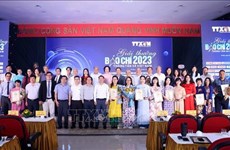Vietnam focuses on developing craft villages
Developing craft villages so they can enable rural residents to
earn a stable income, is one of the Ministry of Agriculture and Rural
Development’s (MARD) major policies, said a senior ministry official.
Developing craft villages so they can enable rural residents to
earn a stable income, is one of the Ministry of Agriculture and Rural
Development’s (MARD) major policies, said a senior ministry official.
During a seminar entitled “One Village, One Product,” which was jointly held by the MARD and the Japan International Cooperation Agency (JICA) in Hanoi on September 15, MARD Deputy Minister Ho Xuan Hung said that drawing up a programme to develop each village with a craft nationwide will stimulate rural employment and will help to change the country’s economic structure, under which the proportion of agricultural products and farmers will drop while those in services and other sectors will increase.
According to a recent survey jointly conducted by MARD and JICA, Vietnam now has 2,017 trade villages producing different products. Of which, only 15 percent are traditional craft villages and the rest are newly-established, small and medium sized ones. The trade villages are mainly being developed in three regions, including the Red River Delta, the Mekong Delta and the North-Western region.
The survey also shows that over 11 million workers, accounting for almost 30 percent of the total workers in trade villages, earn the major part of their income from traditional crafts. Several craft villages employ more than 60 percent of the total local workforce involved in non-agricultural activities. Besides permanent workers, they also attract a large number of seasonal workers.
The incomes of people who are employed in non-agricultural work are 3-4 times higher than those of farmers. Therefore, the poverty rate in areas where trade villages develop only stands at around 3.7 percent, much lower than the country’s average rate of 10.4 percent.
However, the development of trade villages in Vietnam is facing several problems such as a shortage of materials, irregular outputs, a polluted environment and a poor infrastructure.
Deputy Minister Hung said that the ministry has plans for rural employment until 2010 with a focus on developing labour-intensive villages that have the advantage of being able to consume products. Also targeted are the development of trade villages with industrial complexes and drawing up plans and strategies to develop human resources and materials input areas.
Also at the seminar, Morihito Hiramatsu, the founder of the “One Village, One Product” movement in Japan, introduced the model, which has been successfully implemented in Japan and other counties in Asia and Africa.
The seminar is part of a JICA-funded project to develop rural employment which began in December 2008. The project aims to build a comprehensive rural occupation development model by developing highly-competitive products and using available local resources, which will help to increase the incomes of rural workers./.
During a seminar entitled “One Village, One Product,” which was jointly held by the MARD and the Japan International Cooperation Agency (JICA) in Hanoi on September 15, MARD Deputy Minister Ho Xuan Hung said that drawing up a programme to develop each village with a craft nationwide will stimulate rural employment and will help to change the country’s economic structure, under which the proportion of agricultural products and farmers will drop while those in services and other sectors will increase.
According to a recent survey jointly conducted by MARD and JICA, Vietnam now has 2,017 trade villages producing different products. Of which, only 15 percent are traditional craft villages and the rest are newly-established, small and medium sized ones. The trade villages are mainly being developed in three regions, including the Red River Delta, the Mekong Delta and the North-Western region.
The survey also shows that over 11 million workers, accounting for almost 30 percent of the total workers in trade villages, earn the major part of their income from traditional crafts. Several craft villages employ more than 60 percent of the total local workforce involved in non-agricultural activities. Besides permanent workers, they also attract a large number of seasonal workers.
The incomes of people who are employed in non-agricultural work are 3-4 times higher than those of farmers. Therefore, the poverty rate in areas where trade villages develop only stands at around 3.7 percent, much lower than the country’s average rate of 10.4 percent.
However, the development of trade villages in Vietnam is facing several problems such as a shortage of materials, irregular outputs, a polluted environment and a poor infrastructure.
Deputy Minister Hung said that the ministry has plans for rural employment until 2010 with a focus on developing labour-intensive villages that have the advantage of being able to consume products. Also targeted are the development of trade villages with industrial complexes and drawing up plans and strategies to develop human resources and materials input areas.
Also at the seminar, Morihito Hiramatsu, the founder of the “One Village, One Product” movement in Japan, introduced the model, which has been successfully implemented in Japan and other counties in Asia and Africa.
The seminar is part of a JICA-funded project to develop rural employment which began in December 2008. The project aims to build a comprehensive rural occupation development model by developing highly-competitive products and using available local resources, which will help to increase the incomes of rural workers./.













